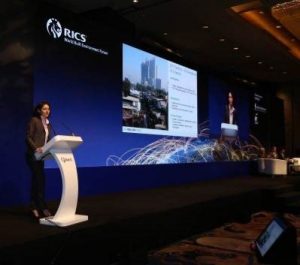
Lauren Sorkin, Regional Director, Asia Pacific of 100 Resilient Cities leading a panel on Resilient Cities at the 2017 World Built Environment Forum
(28 March 2017, Shanghai) The inaugural World Built Environment Forum in Shanghai, China has concluded with 53 speakers sharing their strategic insights with over 700 participants from some 20 countries. Leading senior professionals and leaders from service providers, corporate occupiers, government and regulatory authorities and financial bodies engaged in both macro and micro level perspectives related to the built environment around China’s ‘One Belt, One Road’ initiative.
(中文简体版请按此)
In a compelling discussion panel, Lauren Sorkin, Regional Director, Asia Pacific of 100 Resilient Cities, led a compelling discussion addressing the approach to building resilience into city designs. 100 Resilient Cities is an organization dedicated to the supporting the principle of building resilient cities around the world. Industry leaders discussed their experiences around new approaches to infrastructure investments that can address the multiple challenges in designing cities to withstand the growing shocks and stresses of the 21st century. An emerging trend that stood out in discussions was the role of Chief Resilience Officers leading these initiative and how cities can and should collaborate to facilitate the building of global best practice.
In the closing keynote speech, Vincent Lo, Chairman, Hong Kong Trade Development Council (HKTDC), and Chairman, Shui On, highlighted the key emerging themes of the 2-day forum. He ended with a strong call for international collaboration, saying, “The Belt and Road cannot just be a Chinese initiative – it has to be global to succeed, because it is a huge undertaking with no fixed scope or borders; it’s up to all of us to define it and take action.”

The closing keynote speech of WBEF 2017 on The Strategic Importance of One Belt One Road (left to right, Vincent Lo, Chairman, Hong Kong Trade Development Council (HKTDC), and Chairman, Shui On; panel moderator James Chau, journalist and television presenter)
Comparing the initiative to a marathon versus a sprint, Lo emphasized that it will span decades and require a tremendous amount of capital: the OECD estimated that in the next 20 years, global infrastructural investment will amount to US$55 trillion, and half of that will be in the Belt and Road countries. That equates to around US$1.5 trillion each year.
From policy point of view, the first stage is G2G (government-to-government coordination) including over 50 cooperation agreements already in place between China’s government and countries along the Belt and Road to cooperate on projects such as industrial zones, utilities, roads, railway and others. Financial institutions such as the AIIB and the Silk Road Fund are also in place with active investment in projects like roads, ports and power plants. The Belt and Road initiative already enjoys strong momentum, with heads of state of over 20 countries scheduled to attend the Belt and Road Forum for International Cooperation in Beijing next month.
From a business and industry point of view, physical connectivity on the Belt and Road presents the first opportunity for participation. Lo noted that the scale and long terms of Belt and Road projects need alternative sources of funding aside from traditional public finance. In time, standard “Belt and Road” financing models may emerge to integrate specific needs and risks for the public and private sectors to participate. Another area of opportunity lies in legal and accounting. Similar to the finance sector, “Belt and Road” models of contracts and terms may emerge as more of these projects are transacted, leading to gradual standardisation.

Vincent Lo, Chairman, Hong Kong Trade Development Council (HKTDC), and Chairman, Shui On, speaking at the 2017 World Built Environment Forum
Lo emphasised that opportunities will abound for in surveying, engineering, planning, design, architecture, and related fields. Being that the work complex, technically, commercially and culturally demanding it will require internationally experienced professionals who can also nurture local talent. Finally Lo stressed that a harmonisation in technical standards moving forward will pave the way for greater integration leading to quality, cost, and efficiency improvements.












